The waterless bathing solution market is valued at USD 1,127.4 million in 2025 and is slated to reach USD 2,644.3 million by 2035, recording an absolute increase of USD 1,516.9 million over the forecast period. This translates into a total growth of 134.5%, with the market forecast to expand at a compound annual growth rate (CAGR) of 8.9% between 2025 and 2035. The overall market size is expected to grow by approximately 2.35X during the same period, supported by increasing demand for convenient hygiene solutions, growing adoption of no-rinse personal care products across healthcare and consumer sectors, and rising preference for portable bathing alternatives in institutional settings.
The waterless bathing solution market represents a specialized segment of the global personal care industry, characterized by technological innovation and robust demand across institutional sales, retail pharmacies, and e-commerce channels. Market dynamics are influenced by evolving hygiene requirements toward convenient solutions, growing interest in healthcare-compatible technologies, and expanding partnerships between personal care manufacturers and healthcare providers in developed and emerging economies. Traditional water-based bathing systems continue evolving as consumers and healthcare facilities seek proven waterless alternatives that offer enhanced convenience and reliable hygiene characteristics.
Consumer behavior in the waterless bathing solution market reflects broader healthcare trends toward portable systems that provide both hygiene effectiveness benefits and extended convenience improvements. The market benefits from the growing popularity of no-rinse body cleanser applications, which are recognized for their superior convenience properties and healthcare compatibility across institutional and retail pharmacy applications. Additionally, the versatility of waterless bathing solutions as both standalone hygiene products and integrated care components supports demand across multiple healthcare applications and consumer segments.
Regional adoption patterns vary significantly, with North American markets showing strong preference for institutional implementations, while European markets demonstrate increasing adoption of retail pharmacy applications alongside conventional institutional systems. The personal care landscape continues to evolve with sophisticated and feature-rich waterless products gaining traction in mainstream operations, reflecting consumer willingness to invest in proven convenience technology improvements and hygiene-oriented features.
The competitive environment features established personal care companies alongside specialized waterless solution manufacturers that focus on unique formulation capabilities and advanced convenience methods. Product efficacy and formulation optimization remain critical factors for market participants, particularly as hygiene requirements and safety standards continue to evolve. Distribution strategies increasingly emphasize multi-channel approaches that combine traditional retail supply chains with direct institutional partnerships through healthcare access agreements and specialty distribution contracts.
Market consolidation trends indicate that larger personal care companies are acquiring specialty waterless developers to diversify their product portfolios and access specialized formulation segments. Advanced hygiene integration has gained momentum as healthcare companies seek to differentiate their offerings while maintaining competitive convenience standards. The emergence of specialized waterless variants, including enhanced liquid formulations and wipe-based options, reflects changing consumer priorities and creates new market opportunities for innovative convenience system developers.
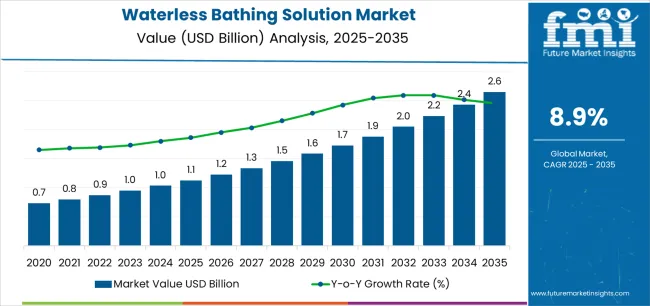
Waterless Bathing Solution Market Key Takeaways
| Metric | Value |
|---|---|
| Estimated Value (2025E) | USD 1,127.4 million |
| Forecast Value (2035F) | USD 2,644.3 million |
| Forecast CAGR (2025 to 2035) | 8.90% |
Between 2025 and 2030, the waterless bathing solution market is projected to expand from USD 1,127.4 million to USD 1,778.9 million, resulting in a value increase of USD 651.5 million, which represents 43.0% of the total forecast growth for the decade. This phase of development will be shaped by increasing adoption of no-rinse cleanser systems, rising demand for institutional healthcare solutions, and growing emphasis on convenience features with advanced formulation characteristics. Healthcare facilities are expanding their hygiene capabilities to address the growing demand for specialized waterless implementations, advanced formulation options, and patient-specific offerings across healthcare segments.
From 2030 to 2035, the market is forecast to grow from USD 1,778.9 million to USD 2,644.3 million, adding another USD 865.4 million, which constitutes 57.0% of the overall ten-year expansion. This period is expected to be characterized by the expansion of retail pharmacy applications, the integration of innovative formulation solutions, and the development of specialized waterless implementations with enhanced convenience profiles and extended hygiene capabilities. The growing adoption of advanced formulation technologies will drive demand for waterless bathing solutions with superior convenience characteristics and compatibility with modern healthcare technologies across institutional operations.
Between 2020 and 2025, the waterless bathing solution market experienced robust growth, driven by increasing demand for no-rinse cleanser systems and growing recognition of convenient hygiene technologies as essential components for modern healthcare and personal care across institutional and consumer applications. The market developed as healthcare providers recognized the potential for waterless solutions to provide both hygiene benefits and operational advantages while enabling streamlined care protocols. Technological advancement in formulation processes and application-based development began emphasizing the critical importance of maintaining hygiene efficacy and user satisfaction in diverse healthcare environments.
Market expansion is being supported by the increasing global demand for convenient hygiene systems and the corresponding need for waterless technologies that can provide superior convenience benefits and hygiene advantages while enabling enhanced healthcare delivery and extended compatibility across various institutional and retail applications.
Modern healthcare providers and consumer specialists are increasingly focused on implementing proven convenience technologies that can deliver effective hygiene maintenance, minimize traditional bathing limitations, and provide consistent performance throughout complex care configurations and diverse patient conditions. Waterless bathing solutions proven ability to deliver exceptional convenience against traditional alternatives, enable advanced healthcare integration, and support modern care protocols makes it an essential component for contemporary institutional and consumer care operations.
The growing emphasis on patient-centric care and hygiene optimization is driving demand for waterless systems that can support complex healthcare requirements, improve patient outcomes, and enable advanced care delivery. Healthcare preference for products that combine effective hygiene maintenance with proven convenience and care enhancement benefits is creating opportunities for innovative waterless implementations. The rising influence of aging population trends and healthcare efficiency awareness is also contributing to increased demand for waterless bathing solutions that can provide advanced features, seamless healthcare integration, and reliable performance across extended care cycles.
The waterless bathing solution market is poised for robust growth and technological advancement. As healthcare facilities across North America, Europe, Asia-Pacific, and emerging markets seek products that deliver exceptional hygiene characteristics, advanced convenience capabilities, and reliable care options, waterless solutions are gaining prominence not just as specialty hygiene products but as strategic enablers of convenience technologies and advanced care functionality.
Rising no-rinse cleanser adoption in institutional applications and expanding retail pharmacy initiatives globally amplify demand, while manufacturers are leveraging innovations in formulation engineering, advanced convenience integration, and hygiene optimization technologies.
The market is segmented by product, form, distribution channels, and region. By product, the market is divided into no-rinse body cleansers, pre-moistened body wipes, no-rinse hair care, intimate & specialty wipes, and others categories. By form, it covers liquid, spray, caps, powders, and others segments. By distribution channels, it encompasses institutional sales, retail pharmacies, e-commerce, and others segments. Regionally, the market is divided into North America, Europe, East Asia, South Asia & Pacific, Latin America, and the Middle East & Africa.
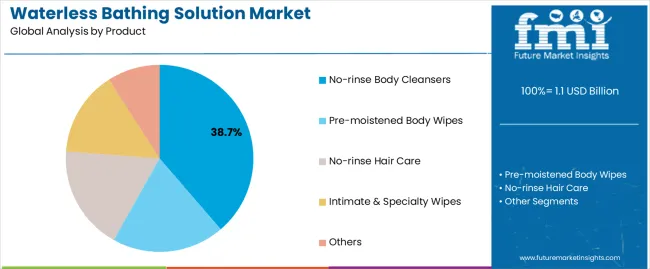
The no-rinse body cleansers segment is projected to account for 38.7% of the waterless bathing solution market in 2025, reaffirming its position as the leading product category. Healthcare facilities and hygiene integrators increasingly utilize no-rinse cleanser implementations for their superior convenience characteristics when operating across diverse care platforms, excellent cleansing properties, and widespread acceptance in applications ranging from basic patient care to premium institutional operations. No-rinse cleanser technology's established formulation methods and proven hygiene capabilities directly address the facility requirements for dependable waterless solutions in complex healthcare environments.
This product segment forms the foundation of modern institutional adoption patterns, as it represents the implementation with the greatest market penetration and established caregiver acceptance across multiple care categories and patient segments. Facility investments in no-rinse cleanser standardization and hygiene consistency continue to strengthen adoption among healthcare providers and institutional facilities. With caregivers prioritizing patient comfort and hygiene efficacy, no-rinse cleanser implementations align with both functionality preferences and cost expectations, making them the central component of comprehensive patient care strategies.
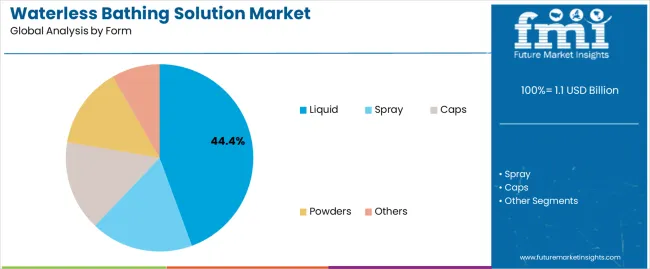
Liquid form applications are projected to represent 44.4% of waterless bathing solutions demand in 2025, underscoring their critical role as the primary form type for hygiene delivery across healthcare operations. Healthcare facilities prefer liquid form for waterless bathing use for their exceptional application characteristics, scalable usage options, and ability to enhance hygiene delivery while ensuring consistent product performance throughout diverse healthcare platforms and patient operations. Positioned as essential hygiene components for modern care systems, liquid solutions offer both technological advantages and application efficiency benefits.
The segment is supported by continuous innovation in formulation technologies and the growing availability of specialized implementations that enable diverse healthcare requirements with enhanced application uniformity and extended patient comfort capabilities. Additionally, healthcare facilities are investing in advanced technologies to support large-scale hygiene integration and product development. As patient-centric care trends become more prevalent and hygiene awareness increases, liquid applications will continue to represent a major implementation market while supporting advanced healthcare utilization and technology integration strategies.
The institutional sales segment is expected to capture 42.2% of the waterless bathing solution market in 2025, driven by increasing demand for healthcare facility solutions that enhance patient care while maintaining operational efficiency. Healthcare institutions are increasingly adopting waterless bathing solutions for long-term care facilities, hospitals, and assisted living centers due to their superior convenience and patient comfort benefits. The segment benefits from growing healthcare infrastructure investment and continuous innovation in institutional-grade formulations tailored for healthcare applications.
The waterless bathing solution market is advancing steadily due to increasing demand for convenient hygiene technologies and growing adoption of waterless systems that provide superior convenience characteristics and hygiene benefits while enabling enhanced patient care across diverse institutional and retail applications. The market faces challenges, including complex regulatory requirements for healthcare products, evolving safety standards, and the need for specialized formulation expertise and quality programs. Innovation in formulation approaches and advanced convenience systems continues to influence product development and market expansion patterns.
Expansion of Aging Population Technologies and Healthcare Integration
The growing adoption of advanced aging care solutions, sophisticated hygiene capabilities, and patient convenience awareness is enabling personal care developers to produce advanced waterless solutions with superior convenience positioning, enhanced formulation profiles, and seamless integration functionalities. Advanced aging care systems provide improved patient outcomes while allowing more efficient healthcare workflows and reliable performance across various healthcare applications and care conditions. Developers are increasingly recognizing the competitive advantages of healthcare integration capabilities for market differentiation and product positioning.
Integration of Advanced Formulation Methods and Convenience Engineering
Modern waterless manufacturers are incorporating advanced formulation technology, convenience integration, and sophisticated care solutions to enhance product appeal, enable intelligent hygiene features, and deliver value-added solutions to healthcare customers. These technologies improve waterless performance while enabling new market opportunities, including multi-benefit hygiene systems, optimized formulation treatments, and enhanced convenience characteristics. Advanced convenience integration also allows developers to support comprehensive healthcare technologies and market expansion beyond traditional hygiene approaches.
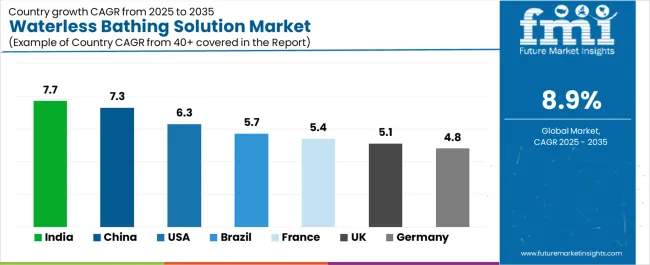
| Countries | CAGR (2025 to 2035) |
|---|---|
| India | 7.7% |
| China | 7.3% |
| USA | 6.3% |
| Brazil | 5.7% |
| France | 5.4% |
| UK | 5.1% |
| Germany | 4.8% |
The waterless bathing solution market is experiencing strong growth globally, with India leading at a 7.7% CAGR through 2035, driven by expanding healthcare infrastructure, growing aging population care programs, and significant investment in hygiene technology development. China follows at 7.3%, supported by increasing healthcare modernization, growing convenience integration patterns, and expanding personal care infrastructure. The USA shows growth at 6.3%, emphasizing healthcare innovation leadership and waterless development.
Brazil records 5.7%, focusing on expanding healthcare capabilities and hygiene technology modernization. France exhibits 5.4% growth, emphasizing convenience excellence and premium hygiene development. The UK demonstrates 5.1% growth, prioritizing advanced healthcare technology development and quality-focused hygiene patterns. Germany shows 4.8% growth, supported by healthcare excellence initiatives and quality-focused convenience patterns.
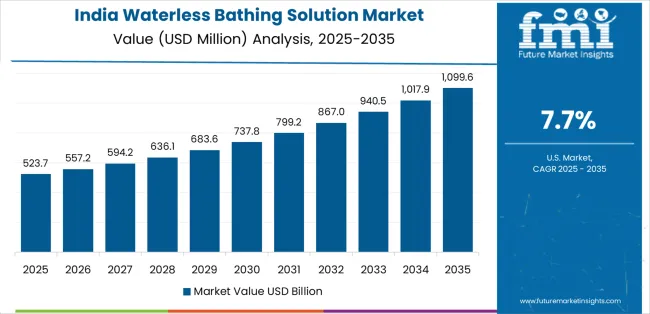
Revenue from waterless bathing solutions in India is projected to exhibit robust growth with a CAGR of 7.7% through 2035, driven by expanding healthcare infrastructure capacity and rapidly growing aging care programs supported by government initiatives promoting hygiene technology development. The country's improving healthcare delivery and increasing investment in convenience infrastructure are creating substantial demand for advanced waterless implementations. Major healthcare facilities and personal care companies are establishing comprehensive hygiene capabilities to serve both urban institutional demand and expanding rural healthcare markets.
Government support for healthcare accessibility initiatives and hygiene development is driving demand for advanced waterless systems throughout major healthcare regions and care centers across the country. Strong healthcare growth and an expanding network of care-focused providers are supporting the rapid adoption of waterless bathing solutions among facilities seeking advanced hygiene capabilities and integrated convenience technologies.
Revenue from waterless bathing solutions in China is growing at a CAGR of 7.3%, driven by the country's expanding healthcare sector, growing aging population, and increasing adoption of advanced hygiene technologies. The country's initiatives promoting healthcare modernization and growing convenience development awareness are driving requirements for technology-integrated hygiene systems. International waterless providers and domestic personal care companies are establishing extensive healthcare and integration capabilities to address the growing demand for advanced hygiene solutions.
Strong healthcare expansion and expanding modern care operations are driving adoption of integrated hygiene systems with superior waterless capabilities and advanced integration among large healthcare providers and progressive care operations. Growing technology diversity and increasing healthcare enhancement adoption are supporting market expansion for advanced waterless implementations with seamless integration profiles and modern hygiene delivery throughout the country's healthcare regions. China's strategic healthcare position and expanding aging population make it an attractive destination for waterless development facilities serving both domestic and Asian markets.
Revenue from waterless bathing solutions in the USA is growing at a CAGR of 6.3%, driven by the country's focus on healthcare innovation advancement, emphasis on premium convenience innovation, and strong position in hygiene development. The USA's established healthcare excellence capabilities and commitment to technology diversification are supporting investment in specialized waterless technologies throughout major healthcare regions. Industry leaders are establishing comprehensive technology integration systems to serve domestic premium healthcare production and enhancement applications.
Innovations in hygiene platforms and healthcare integration capabilities are creating demand for advanced waterless implementations with exceptional convenience properties among progressive healthcare facilities seeking enhanced technology differentiation and patient appeal. Growing premium healthcare adoption and increasing focus on convenience innovation are driving adoption of advanced waterless platforms with integrated hygiene delivery and care optimization across healthcare enterprises throughout the country.
Revenue from waterless bathing solutions in Brazil is growing at a CAGR of 5.7%, driven by the country's expanding healthcare sector, growing aging population programs, and increasing investment in hygiene technology development. Brazil's large healthcare market and commitment to care advancement are supporting demand for diverse waterless solutions across multiple healthcare segments. Healthcare providers are establishing comprehensive hygiene capabilities to serve the growing domestic market and expanding care opportunities.
Strong healthcare expansion and expanding modern care operations are driving adoption of integrated hygiene systems with superior waterless capabilities and advanced integration among large healthcare providers and progressive care operations. Growing technology diversity and increasing healthcare enhancement adoption are supporting market expansion for advanced waterless implementations with seamless integration profiles and modern hygiene delivery throughout the country's healthcare regions.
Revenue from waterless bathing solutions in France is growing at a CAGR of 5.4%, driven by the country's established healthcare sector, growing aging care programs, and increasing investment in hygiene technology development. France's mature healthcare system and commitment to convenience excellence are supporting demand for diverse waterless solutions across multiple care segments. Personal care providers are establishing comprehensive hygiene capabilities to serve the growing domestic market and expanding healthcare opportunities.
Strong healthcare expansion and expanding modern care operations are driving adoption of integrated hygiene systems with superior waterless capabilities and advanced integration among large healthcare providers and progressive care operations. Growing care diversity and increasing healthcare enhancement adoption are supporting market expansion for advanced waterless implementations with seamless integration profiles and modern hygiene delivery throughout the country's healthcare regions.
Revenue from waterless bathing solutions in the UK is growing at a CAGR of 5.1%, driven by the country's focus on healthcare advancement, emphasis on premium convenience innovation, and strong position in hygiene development. The UK's established healthcare excellence capabilities and commitment to technology diversification are supporting investment in specialized waterless technologies throughout major healthcare regions. Healthcare leaders are establishing comprehensive technology integration systems to serve domestic premium care production and enhancement applications.
Innovations in hygiene platforms and healthcare integration capabilities are creating demand for advanced waterless implementations with exceptional convenience properties among progressive healthcare facilities seeking enhanced technology differentiation and patient appeal. Growing premium healthcare adoption and increasing focus on convenience innovation are driving adoption of advanced waterless platforms with integrated hygiene delivery and care optimization across healthcare enterprises throughout the country.
Revenue from waterless bathing solutions in Germany is expanding at a CAGR of 4.8%, supported by the country's healthcare excellence initiatives, growing quality technology sector, and strategic emphasis on advanced convenience development. Germany's advanced quality control capabilities and integrated healthcare systems are driving demand for high-quality waterless platforms in premium applications, healthcare technology, and advanced care applications. Leading facilities are investing in specialized capabilities to serve the stringent requirements of technology-focused healthcare and premium care providers.
Quality healthcare advancement and technology-focused development are creating requirements for specialized waterless solutions with superior quality integration, exceptional hygiene capabilities, and advanced convenience features among quality-conscious healthcare operations and premium care providers. Strong position in healthcare technology innovation is supporting adoption of advanced waterless systems with validated hygiene characteristics and quality integration capabilities throughout the country's healthcare technology sector.
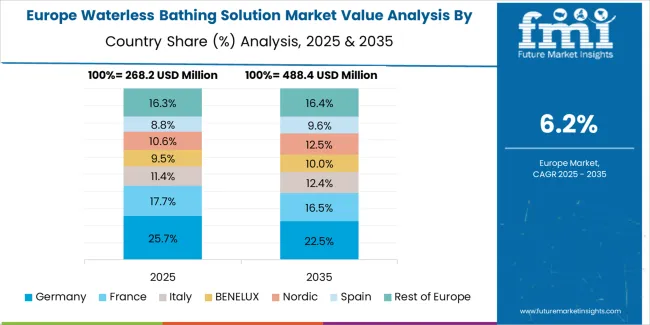
The waterless bathing solution market in Europe is projected to grow from USD 200.9 million in 2025 to USD 341.0 million by 2035, registering a CAGR of 5.4% over the forecast period. Germany is expected to maintain its leadership position with a 25.7% market share in 2025, growing to 30.4% by 2035, supported by its strong healthcare excellence culture, sophisticated aging care capabilities, and comprehensive personal care sector serving diverse waterless applications across Europe.
France follows with a 19.1% share in 2025, projected to reach 23.8% by 2035, driven by robust demand for healthcare technologies in care applications, advanced convenience development programs, and hygiene enhancement markets, combined with established healthcare infrastructure and technology integration expertise. Spain holds a 18.0% share in 2025, expected to reach 24.6% by 2035, supported by growing healthcare activities.
Italy commands a 9.0% share in 2025, projected to reach 11.8% by 2035, while BENELUX accounts for 5.9% in 2025, expected to reach 7.1% by 2035. Nordic Countries maintain a 1.1% share in 2025, growing to 1.2% by 2035. The Rest of Western Europe region is anticipated to maintain momentum, with its collective share moving from 1.2% to 1.1% by 2035, attributed to increasing healthcare modernization and growing technology penetration implementing advanced hygiene programs.
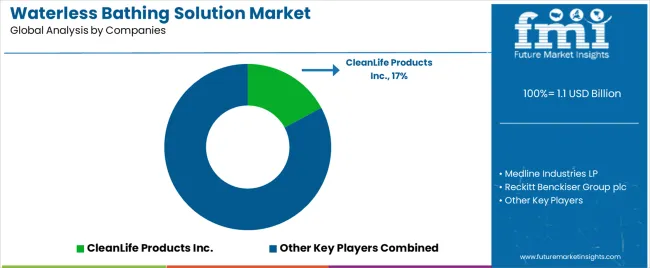
The waterless bathing solution market is characterized by competition among established personal care companies, specialized hygiene manufacturers, and integrated healthcare solution providers. Companies are investing in formulation research, convenience optimization, advanced healthcare system development, and comprehensive hygiene portfolios to deliver consistent, high-quality, and patient-specific waterless solutions. Innovation in advanced formulation integration, convenience enhancement, and healthcare compatibility improvement is central to strengthening market position and competitive advantage.
CleanLife Products Inc. leads the market with a 17.2% market share, offering comprehensive hygiene solutions including quality formulation platforms and advanced waterless systems with a focus on premium and institutional applications. Medline Industries LP provides specialized healthcare capabilities with an emphasis on advanced waterless implementations and innovative hygiene solutions. Reckitt Benckiser Group plc delivers comprehensive consumer services with a focus on integrated platforms and large-scale retail applications. Coloplast A/S specializes in advanced healthcare technologies and specialized waterless implementations for premium care applications.
The competitive landscape is further strengthened by emerging companies focusing on innovative formulations and specialized care solutions. These companies continue to invest in research and development, strategic partnerships, and manufacturing capacity expansion to maintain their market positions and capture emerging opportunities in the growing waterless bathing solution sector. The market benefits from continuous innovation in formulation technologies, expanding distribution networks, and increasing healthcare facility adoption of waterless hygiene solutions.
| Item | Value |
|---|---|
| Quantitative Units | USD 1,127.4 million |
| Product | No-rinse Body Cleansers; Pre-moistened Body Wipes; No-rinse Hair Care; Intimate & Specialty Wipes; Others |
| Form | Liquid; Spray; Caps; Powders; Others |
| Distribution Channels | Institutional Sales; Retail Pharmacies; E-commerce; Others |
| Regions Covered | North America; Europe; East Asia; South Asia & Pacific; Latin America; Middle East & Africa |
| Countries Covered | USA; Germany; France; UK; Japan; China; India; South Korea; Brazil; and 40+ additional countries |
| Key Companies Profiled | CleanLife Products Inc.; Medline Industries LP; Reckitt Benckiser Group plc; Coloplast A/S |
| Additional Attributes | Dollar sales by product and form category; regional demand trends; competitive landscape; technological advancements in formulation engineering; advanced convenience development; hygiene innovation; healthcare integration protocols |
The global waterless bathing solution market is estimated to be valued at USD 1.1 billion in 2025.
The market size for the waterless bathing solution market is projected to reach USD 2.6 billion by 2035.
The waterless bathing solution market is expected to grow at a 8.9% CAGR between 2025 and 2035.
The key product types in waterless bathing solution market are no-rinse body cleansers, pre-moistened body wipes, no-rinse hair care, intimate & specialty wipes and others.
In terms of form, liquid segment to command 44.4% share in the waterless bathing solution market in 2025.






Full Research Suite comprises of:
Market outlook & trends analysis
Interviews & case studies
Strategic recommendations
Vendor profiles & capabilities analysis
5-year forecasts
8 regions and 60+ country-level data splits
Market segment data splits
12 months of continuous data updates
DELIVERED AS:
PDF EXCEL ONLINE
Waterless Cosmetics Powders Market Size and Share Forecast Outlook 2025 to 2035
Waterless Cosmetics Market Analysis - Growth & Forecast 2025 to 2035
Pet Bathing Supplies Market Growth - Trends & Forecast to 2035
Preoperative Bathing Solution Market Analysis by End User into Intensive Care Unit, Surgical Wards and Medical Wards Through 2035.
Solution Styrene Butadiene Rubber (S-SBR) Market Size and Share Forecast Outlook 2025 to 2035
NGS Solution for Early Cancer Screening Market Size and Share Forecast Outlook 2025 to 2035
5PL Solutions Market
High-Resolution Anoscopy Market Size and Share Forecast Outlook 2025 to 2035
mHealth Solutions Market Size and Share Forecast Outlook 2025 to 2035
Super Resolution Microscope Market Insights - Size, Share & Forecast 2025 to 2035
G-3 PLC Solution Market – Smart Grids & Connectivity
Docketing Solution Market Size and Share Forecast Outlook 2025 to 2035
Long Haul Solutions Market Size and Share Forecast Outlook 2025 to 2035
eClinical Solutions and Software Market Insights - Trends & Forecast 2025 to 2035
E-tailing Solutions Market Growth – Trends & Forecast 2020-2030
Connected Solutions for Oil & Gas Market Insights – Trends & Forecast 2020-2030
Biocontrol Solutions Market Size and Share Forecast Outlook 2025 to 2035
WealthTech Solutions Market Size and Share Forecast Outlook 2025 to 2035
Smart Home Solutions Market Size and Share Forecast Outlook 2025 to 2035
Geospatial Solution Market Analysis - Size, Share, and Forecast Outlook for 2025 to 2035

Thank you!
You will receive an email from our Business Development Manager. Please be sure to check your SPAM/JUNK folder too.
Chat With
MaRIA